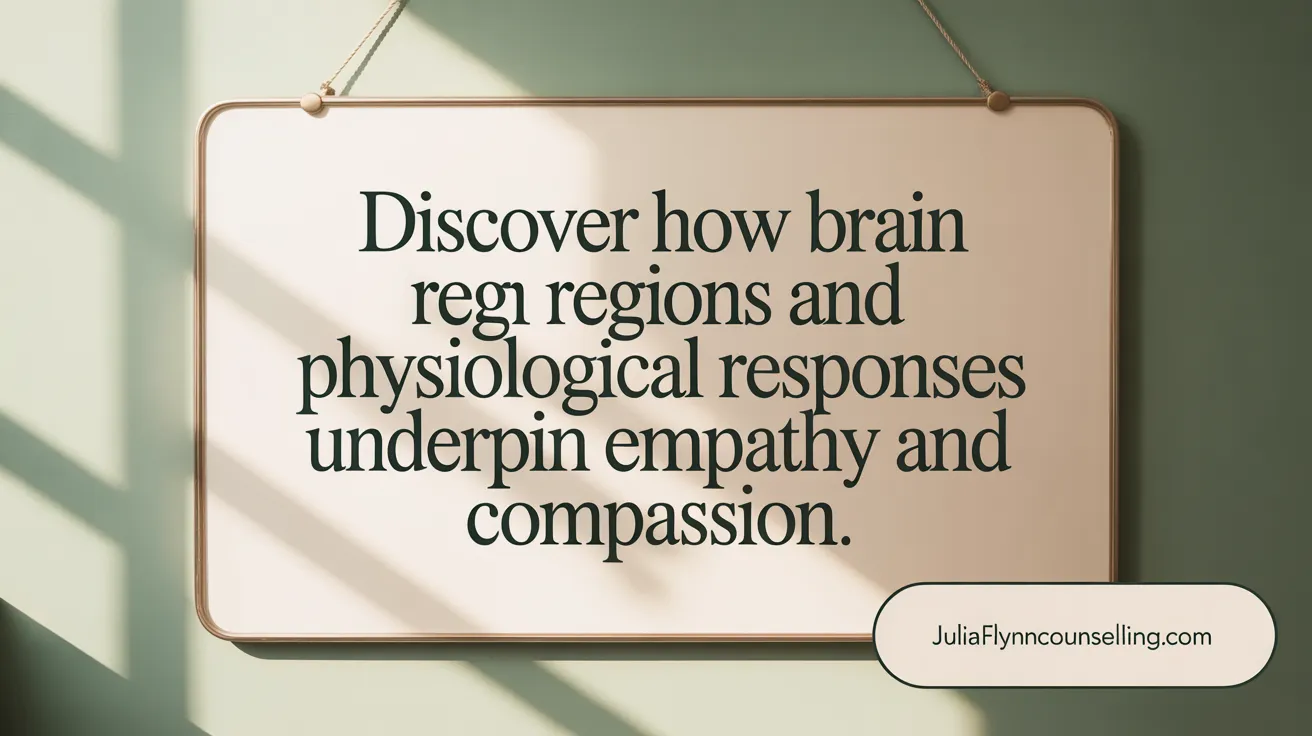Understanding Compassion’s Transformative Power in Therapy
Compassion serves as a cornerstone in therapeutic relationships, enabling trust, healing, and profound emotional connection. Beyond empathy, compassion embodies a deeper emotional engagement and motivation to alleviate suffering, creating safe spaces where clients feel valued and understood. This article explores how compassion is defined and applied within therapy, its vital role in building trust, methods for cultivating it, and its impact on trauma treatment and the overall therapeutic process.
Defining Compassion in Therapeutic Contexts: More Than Empathy
What is the distinction between compassion and empathy in therapy?
Compassion extends beyond mere understanding and sharing of feelings, engaging a deeper motivation to alleviate suffering. While empathy involves recognizing and resonating with a client's emotional state, compassion adds an active dimension, driven by a desire to support and heal. It includes emotional awareness of distress and the willingness to take supportive actions.
How is compassion defined and applied in therapeutic contexts?
In therapy, compassion is viewed as a sensitive awareness of suffering—both one's own and others'. It is coupled with a motivation to help, fostered through understanding, emotional engagement, and supportive behaviors. Therapists cultivate this quality by recognizing clients’ pain and responding with kindness, patience, and genuine concern.
Applied compassion involves specific skills and practices. Techniques such as mindfulness, imagery exercises, and compassionate mind training help clients and therapists develop a compassionate stance. These practices encourage clients to reframe negative self-beliefs, manage shame, and foster self-acceptance.
What are therapeutic approaches that emphasize compassion, such as CFT?
Compassion-Focused Therapy (CFT) is one of the most prominent approaches emphasizing compassion. It aims to develop a compassionate mind by addressing misconceptions about kindness, cultivating motivation, and enhancing emotional regulation skills. CFT often incorporates imagery exercises, mindfulness, and compassion training to help clients soothe themselves and build resilience.
Other approaches—like Person-Centered Therapy, Mindfulness-Based Stress Reduction (MBSR), and Trauma-Informed Care—integrate compassion as a core element, fostering a non-judgmental, accepting environment that promotes healing.
What challenges exist in integrating compassion into practice?
Practitioners face challenges such as managing personal biases, overcoming fears of vulnerability, and resisting burnout or compassion fatigue. Building genuine compassion requires self-awareness, continuous reflection, and balancing professional boundaries.
Successfully integrating compassion involves overcoming resistance rooted in attachment styles, past traumas, or misconceptions about vulnerability. This is often achieved through experiential exercises and psychoeducation that deepen therapists’ capacity for compassionate engagement.
Overall, compassion in therapy is an active process that entails recognizing suffering and responding with kindness and support. When effectively incorporated, it enhances the therapeutic alliance, fosters trust, and promotes meaningful healing.
The Crucial Role of Compassion in Building Therapeutic Trust

How does compassion foster safety and acceptance?
Compassion is fundamental in creating a safe and accepting therapeutic environment. When therapists approach clients with genuine concern, kindness, and understanding, clients are more likely to feel valued and respected. This emotional safety encourages them to share deeply personal thoughts and feelings without fear of judgment.
Research shows that compassionate therapy helps reduce feelings of shame and self-criticism, making it easier for clients to open up. This sense of acceptance is crucial in mental health treatment, as it nurtures trust and supports authentic healing.
How does the empathic connection and attunement to clients enhance trust?
The core of compassion involves attunement—an intuitive understanding of a client’s emotional state. This connection goes beyond basic understanding; it involves sensing and responding to what clients experience on a deeper level.
By being present and focused on the client’s emotions, therapists can interpret non-verbal cues and underlying needs. This attunement helps clients feel truly seen and understood, which reinforces their trust in the therapist.
What techniques can therapists use to demonstrate compassion and build trust?
Therapists can employ several practical techniques to show compassion:
| Technique | Description | Impact on Trust |
|---|---|---|
| Active listening | Giving full attention, paraphrasing, and reflecting emotions | Makes clients feel heard and valued |
| Open-ended questions | Encouraging clients to express themselves freely | Shows genuine interest and respect |
| Warm body language | Maintaining eye contact, nodding, and an open posture | Enhances perceived warmth and safety |
| Emotional validation | Acknowledging and accepting clients’ feelings | Builds emotional safety and trust |
| Mindfulness and presence | Staying focused on the moment and being fully present with the client | Deepens connection and attunement |
How does compassion impact the therapeutic alliance, and what effect does it have on client openness?
When therapists demonstrate compassion consistently, it strengthens the therapeutic alliance—the collaborative bond between client and therapist. A strong alliance is associated with better treatment outcomes.
Compassionate responses and behaviors reassure clients that their feelings are understood, reducing their fears and resistance.
As a result, clients become more willing to share honest and vulnerable insights. This openness fosters deeper exploration, accelerates progress, and increases the overall effectiveness of therapy.
By integrating compassion into their practice, therapists help clients feel safe enough to confront difficult emotions, leading to sustainable healing and growth.
Compassion’s Influence on Healing and Therapeutic Progress

How does compassion influence the therapeutic process and promote healing?
Compassion plays a vital role in therapy by creating a deep emotional connection between the therapist and the client. This connection fosters trust and safety, making clients feel accepted and understood. When clients perceive that their therapist genuinely cares and responds with empathy and kindness, they are more likely to open up about their vulnerabilities and emotional struggles.
This openness supports emotional regulation and resilience. Compassionate interactions help clients manage distress, reduce feelings of shame, and develop healthier ways to handle their emotions. As clients feel supported and validated, they become more motivated to work through difficult issues and pursue positive change.
Research indicates that compassion activates neural reward pathways in both clients and therapists, strengthening the therapeutic alliance. This activation fosters a sense of connection and mutual trust, which is crucial for effective therapy.
Moreover, compassion in therapy can lead to physiological benefits such as reduced stress, lower inflammation levels, and decreased perception of pain. These effects support faster recovery from psychological and physical ailments.
Effective compassion enhances communication, making conversations more honest and productive. This improvement translates into higher client satisfaction, better adherence to treatment plans, and ultimately, more successful healing outcomes.
Techniques to Cultivate Compassion and Enhance Emotional Regulation in Therapy

What techniques and methods can therapists use to cultivate compassion in therapy to enhance trust and emotional regulation?
Therapists can foster compassion within the therapeutic process through various practical approaches. Mindfulness practices, such as loving-kindness meditation, are effective tools. These exercises encourage both therapists and clients to generate feelings of warmth, kindness, and acceptance toward themselves and others. Regular mindfulness reflection helps cultivate a compassionate mindset, which in turn makes therapy more empathetic and trustworthy.
In addition to mindfulness, specific therapeutic approaches like Compassion-Focused Therapy (CFT) and self-compassion training are designed to target emotional vulnerabilities such as shame and self-criticism. These methods guide clients in recognizing and soothing their inner critic, building a kinder relationship with themselves. Teaching self-compassion involves addressing common inner dialogues and helping clients realize that suffering is a shared human experience, which promotes emotional regulation and resilience.
Guided visualizations and compassionate inner dialogues are also beneficial. Visualizing a compassionate figure or engaging in self-talk that emphasizes understanding and kindness can reduce stress and increase emotional stability. These practices create a safe mental space where clients can access their inner kindness, especially during challenging moments.
Therapists play an essential role by modeling empathetic behavior and validating clients’ emotions. This modeling encourages clients to mirror compassionate responses in their own lives. Moreover, encouraging clients to practice self-compassion—such as taking mindful breaks for kindness or addressing self-critical thoughts—helps deepen their emotional regulation.
Overall, these methods—ranging from mindfulness and visualization to structured compassionate training—support clients in developing kindness toward themselves and others. This expansion of compassion facilitates trust, reduces emotional distress, and promotes a healing environment where clients can confidently explore and resolve their emotional challenges.
The Vital Importance of Compassion in Trauma Therapy and Mental Health Treatment
How does compassion create safety and openness in trauma therapy?
Compassion plays a crucial role in establishing a safe and welcoming environment during trauma therapy. When therapists demonstrate genuine care, non-judgmental support, and acceptance, clients feel more comfortable sharing deep-seated fears and painful memories. This emotional safety helps clients lower their defenses, facilitating honest communication and the surrender of shame.
Research highlights that compassionate interactions, even non-verbal cues like warm body language and attentive presence, activate neural systems linked to trust and safety. This foundation encourages clients to explore difficult emotions without feeling judged or threatened, fostering a conducive space for healing and growth.
Creating such an environment involves therapists being present, practicing active listening, and offering empathetic responses that validate clients’ feelings. These techniques not only deepen trust but also activate the client’s self-soothing mechanisms, making trauma processing more accessible and less overwhelming.
What is the role of self-compassion in affect regulation and PTSD symptoms?
Self-compassion is fundamental in helping individuals manage intense emotions and reduce the symptoms of PTSD. By practicing self-kindness, recognizing shared human experiences, and cultivating mindfulness, clients can better regulate their emotional responses.
Studies show that higher levels of self-compassion are linked with decreased PTSD symptoms, greater resilience, and increased capacity for post-traumatic growth. When clients learn to treat themselves with the same kindness they would offer a friend, they reduce self-criticism and shame, which are often intensified by trauma.
Self-compassion exercises help clients stabilize their emotional states, enabling them to process trauma-related feelings more effectively. This internal support system fosters resilience, allowing individuals to face challenging memories without becoming overwhelmed.
How do compassion-focused therapies support trauma treatment?
Compassion-focused therapies (CFT) emphasize developing compassion within oneself and toward others as a pathway to healing trauma. These approaches incorporate practices such as compassionate imagery, developing a compassionate self, and understanding one’s emotional states.
In trauma work, CFT helps clients access and soothe painful emotions by nurturing a sense of warmth and safety internally. Instead of confronting trauma through exposure alone, which can sometimes escalate anxiety, CFT offers a gentler path by promoting affect regulation through compassionate emotional engagement.
This approach can be particularly effective for clients resistant to traditional trauma narratives or those with complex PTSD. Therapeutic techniques like the multiple selves exercise allow clients to understand different emotional parts, facilitating integration and healing.
What are the roles of mercy, genuine affection, and non-judgmental support in trauma therapy?
Mercy and genuine affection are foundational to the therapeutic relationship, fostering trust and deepening the client’s sense of being truly understood. When therapists demonstrate mercy—giving clients patience and space to heal without rushing or pressuring—they communicate that healing takes time and that setbacks are normal.
Genuine affection, manifested through warmth, caring gestures, and consistent kindness, helps break down emotional barriers, especially in clients who have experienced abandonment or judgment in past relationships. This fosters an environment of unconditional positive regard.
Non-judgmental support means accepting clients’ stories and emotions without criticism or shame. This attitude encourages honesty and openness, vital for processing traumatic experiences. Overall, compassion—embodying mercy, genuine affection, and acceptance—is essential for creating a nurturing space conducive to lasting healing.
The Science Behind Compassion: Neurological and Physiological Perspectives

Brain mechanisms underpinning empathy and compassion
Scientists have mapped how our brains process empathy and compassion. Brain imaging studies have shown that specific areas, such as the mirror neuron system, activate when we observe others in distress, enabling us to feel connected and responsive. Additionally, regions like the anterior insula and anterior cingulate cortex are involved in emotional resonance and understanding others' feelings.
Effects of compassion on stress, pain, and relaxation
Practicing compassion has remarkable effects on our physiological state. Acts of compassion can reduce stress levels by decreasing cortisol, the stress hormone. It also helps alleviate pain by activating brain regions associated with natural pain relief, such as the release of endorphins. These responses promote relaxation, foster emotional openness, and enhance overall well-being.
Physiological impact of non-verbal compassionate communication
Even without words, compassionate behaviors like a warm smile or gentle touch trigger calming physiological responses. These non-verbal cues activate the parasympathetic nervous system, leading to decreased heart rate and lower blood pressure. For clients, such non-verbal expressions of empathy build trust and deepen emotional safety within therapy sessions.
Compassion’s role in therapist-client relational dynamics
The mutual experience of compassion strengthens the therapeutic relationship. Neurobiological research demonstrates that therapist and client’s brain activity can become attuned through sustained compassionate interactions, fostering trust and openness. This synchronization enhances the therapeutic alliance and is associated with better treatment outcomes.
| Aspect | Brain Regions Involved | Physiological Effects | Relevance in Therapy |
|---|---|---|---|
| Empathy Processing | Mirror neuron system, anterior insula, anterior cingulate | Emotional mirroring, stress reduction | Builds understanding and trust |
| Compassion Activation | Prefrontal cortex, limbic system | Stress relief, oxytocin release, relaxation | Facilitates bonding and emotional safety |
| Non-verbal Communication | Facial muscles, touch receptors | Heart rate stabilization, decreased tension | Enhances emotional safety and connection |
Understanding the neuroscience underlying compassion emphasizes its importance not just emotionally, but biologically, in fostering therapeutic change. It shows that compassionate interactions activate natural relaxation and bonding systems in both clients and therapists, creating a foundation for effective healing.
Nurturing Compassion: Therapist Self-Awareness and Overcoming Challenges

Importance of therapist self-awareness and reflective practice
A crucial aspect of effective therapy is the therapist's ability to stay self-aware. Regular reflective practice helps therapists recognize their own emotional responses, biases, and triggers. This awareness ensures that they can provide genuine empathy without projecting personal issues onto clients. Self-awareness fosters authenticity and enhances the therapist's capacity for compassionate engagement.
Managing personal biases and emotional boundaries
Therapists must actively manage personal biases to prevent them from influencing the therapeutic process. Maintaining clear emotional boundaries is essential to preserve a professional, non-judgmental environment. Practicing mindfulness and ongoing self-assessment allow therapists to navigate their own emotional landscape skillfully, ensuring that compassion remains balanced and appropriate.
Avoiding compassion fatigue
Constant emotional investment can lead to compassion fatigue, where therapists feel drained and detached. To prevent this, it is vital to incorporate self-care routines, set realistic boundaries, and seek peer support. Recognizing signs of exhaustion early helps therapists re-engage with their work compassionately without risking burnout.
Continuous education and mindfulness for sustaining compassion
Engaging in continuous education broadens understanding of cultural and individual differences, enhancing empathetic and compassionate skills. Mindfulness practices, such as meditation and breathing exercises, promote resilience, presence, and emotional regulation. These techniques help therapists sustain their compassion over time, ensuring they can provide consistent, high-quality support to clients.
Compassion as the Foundation for Trust and Healing in Therapy
Compassion is the heartbeat of effective therapy, weaving trust, safety, and emotional connection into the fabric of healing relationships. It transcends empathy by not only recognizing suffering but actively motivating compassionate action that supports clients’ journeys toward well-being. Through deliberate cultivation of compassionate practices and self-awareness, therapists can foster therapeutic alliances grounded in acceptance and understanding, crucial for trauma recovery and mental health improvement. Integrating compassion into the therapeutic process thereby enriches communication, enhances emotional regulation, and promotes resilience. Ultimately, the presence of compassion invites clients to experience themselves with kindness and trust, creating a therapeutic environment where true transformation becomes possible.
References
- The Role of Empathy in Effective Counseling: Techniques ...
- Emotion Processing and the Role of Compassion in ...
- Why Empathy is Essential for Building Trust in Therapy
- The Power of Compassion in Trauma Therapy and Coaching
- Compassionate Therapy Approaches
- The Empathic Connection: Building Trust in Therapy
- The Presence of Compassion in Therapy
